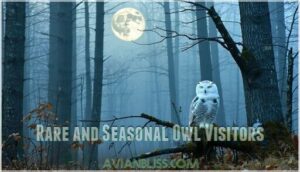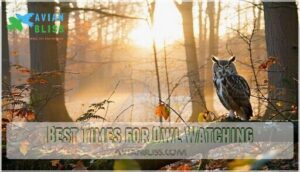This site is supported by our readers. We may earn a commission, at no cost to you, if you purchase through links.

The state hosts five year-round residents: the powerful Great Horned Owl that’ll snatch prey from your backyard, the forest-loving Barred Owl with its unmistakable "who-cooks-for-you" call, the compact Eastern Screech-Owl hiding in tree cavities, the ghostly white Barn Owl silently patrolling marshes, and the tiny Northern Saw-whet Owl with its whistling call.
Three seasonal visitors include the Arctic Snowy Owl during winter irruptions, the grassland-hunting Short-eared Owl, and the increasingly rare Long-eared Owl.
Each species occupies specific niches across Maryland’s diverse landscapes, from Chesapeake marshes to Appalachian forests, and proper identification requires understanding their size variations, distinctive calls, and behavioral patterns that reveal which mysterious nighttime neighbor might be roosting nearby.
Table Of Contents
- Key Takeaways
- Common Owls Found in Maryland
- Rare and Seasonal Owl Visitors
- Owl Identification Guide for Maryland
- Owl Habitats and Where to Spot Them
- Attracting and Protecting Owls Locally
- Frequently Asked Questions (FAQs)
- Is it good to have an owl in your yard?
- Why is there owls around my house?
- What to do if an owl is in your yard?
- What time of year are owls most active?
- Do owls have good eyesight?
- What do baby owls eat?
- Do owls fly in flocks?
- How long do owls live?
- What is an owl pellet?
- What do Maryland owls eat during winter?
- Conclusion
Key Takeaways
- You’ll find eight distinct owl species in Maryland – five year-round residents (Great Horned, Barred, Eastern Screech, Barn, and Northern Saw-whet) and three seasonal visitors (Snowy, Short-eared, and Long-eared)
- You can identify Maryland’s owls by listening for their unique calls – Barred Owls ask "who-cooks-for-you," Great Horned Owls deliver deep hoots, Eastern Screech-Owls produce whinnying trills, and Barn Owls screech harshly instead of hooting
- You’ll spot owls most effectively during dawn and dusk hours in their preferred habitats – dense forests for Barred Owls, open grasslands for Short-eared Owls, and suburban areas with mature trees for Great Horned and Eastern Screech-Owls
- You can attract owls to your property by installing species-specific nest boxes, preserving natural tree cavities, maintaining quiet hours during peak activity times, and reporting sightings to citizen science platforms like eBird
Common Owls Found in Maryland
Maryland’s forests and wetlands host five common owl species that you can spot year-round with the right timing and location knowledge.
These resident owls have adapted to the state’s diverse habitats, from dense woodlands to suburban neighborhoods, making identification both rewarding and accessible for local birdwatchers.
Barred Owl
Spotting Maryland’s most vocal resident, the Barred Owl thrives in mature forests and wooded swamps throughout the state.
These medium-sized maryland owl species produce their famous "who-cooks-for-you" call year-round.
Barred Owl Habitat includes dense woodlands near water sources, where Barred Owl Diet consists primarily of small mammals, amphibians, and fish.
Unlike migratory species, these maryland birds remain local residents, making Barred Owl Behavior predictable for dedicated birdwatchers seeking consistent maryland owl sightings.
Understanding the importance of bird habitat diversity is vital for conservation efforts and spotting various owl species in their natural environments.
Great Horned Owl
You’ll recognize this apex predator by its distinctive "horns" – actually feather tufts that enhance its intimidating presence.
Those horns aren’t horns at all—just fierce feather tufts that make this hunter look absolutely intimidating
Great Horned Owls dominate Maryland’s nocturnal landscape through superior hunting tactics and remarkable feather adaptation.
Their mottled brown owl camouflage provides perfect concealment against tree bark.
These maryland owl species exhibit aggressive nocturnal behavior, even preying on other owls.
Despite habitat loss pressures, these resilient maryland birds remain common across diverse environments, making owl conservation efforts particularly important for maintaining healthy maryland wildlife populations.
Eastern Screech-Owl
The Eastern Screech-Owl perfectly embodies stealth and adaptation among Maryland wildlife. Unlike larger species, these pocket-sized hunters rely on exceptional feather camouflage and haunting screech calls to navigate their world.
- Gray and rufous color morphs blend seamlessly with tree bark patterns
- Hollow tree cavities serve as preferred nesting sites in suburban areas
- Tremolo calls and whinnying sounds echo through neighborhoods at dusk
- Eight-inch compact frame allows easy movement through dense forest understory
Their habitat needs include mature trees with natural cavities, making urban parks ideal locations.
These adaptable birds demonstrate remarkable owl behavior, switching between camouflaged daytime roosts and active nighttime hunting.
Maryland birding enthusiasts often locate them by following their distinctive vocalizations.
Their nesting habits favor old woodpecker holes, supporting owl conservation efforts when dead trees remain standing.
Understanding maryland owl facts helps protect these remarkable nocturnal neighbors.
Northern Saw-whet Owl
Don’t let size fool you—the Northern Saw-whet Owl packs impressive hunting tactics into its seven-inch frame.
These pint-sized predators exhibit remarkable migration patterns through Maryland each fall, using nocturnal behavior and specialized feather adaptations for silent flight.
Their distinctive whistling call echoes through dense woodlands, making maryland birding adventures unforgettable when you discover their secretive nesting habits.
Barn Owl
During winter months, you’ll spot Maryland’s most ghostly owl species gliding silently across farmlands and marshes.
The Barn Owl’s heart-shaped white facial disc and golden-buff plumage make identification easy.
These nocturnal hunting specialists consume up to 1,000 mice annually, using silent flight to surprise prey in their preferred barn owl habitat of agricultural areas and grasslands throughout Maryland.
Rare and Seasonal Owl Visitors
While Maryland hosts eight owl species, three appear only occasionally as rare visitors or during specific seasons.
You’ll need patience and luck to spot these elusive species, as they follow unpredictable migration patterns and favor specific weather conditions for their brief appearances in the state, requiring luck to observe them.
Snowy Owl
Spotting these Arctic migrants during maryland bird species surveys feels like discovering treasure.
Snowy Owl Habitat preferences include coastal marshes and open fields, mimicking their tundra origins.
Their Snowy Feathers provide perfect owl camouflage against winter landscapes.
Arctic Migration brings these heaviest North American owls south during irruption years.
Winter Adaptation allows diurnal hunting, unlike typical owl migration patterns.
Visit maryland wildlife refuge locations like Assateague Island for ideal bird watching maryland experiences.
To increase the chances of spotting Snowy Owls, researchers study wildlife photography techniques to better understand their behavior.
Short-eared Owl
Short-eared owls present a fascinating case study in owl migration patterns and habitat preferences among maryland raptors.
These nomadic hunters rely heavily on grassland ecosystems, making habitat loss a significant threat to their conservation status.
Unlike other maryland bird species, shorteared owls employ distinctive low-flight hunting tactics, gliding silently over open marshes and fields.
Their sporadic appearances during bird watching maryland excursions reflect complex owl behavior tied to prey availability and seasonal movements, making each sighting particularly rewarding for dedicated observers.
Long-eared Owl
These secretive forest dwellers historically nested in Maryland but rarely appear today.
Long-eared Owls prefer dense woodlands where their cryptic plumage provides perfect camouflage.
During Owl Migration periods, bird watching maryland enthusiasts might spot these maryland raptors using Silent Flight techniques.
Key identification features for owl identification:
- Distinctive ear tufts – Long feathered "horns" when alert
- Orange facial discs – Rusty-colored around bright yellow eyes
- Nocturnal Behavior patterns – Most active during complete darkness
Their owl behavior includes roosting communally in thick Forest Habitats during winter months.
Owl Identification Guide for Maryland
Identifying Maryland’s eight owl species requires attention to key physical features and behavioral patterns that distinguish each bird.
You’ll need to observe size variations, plumage patterns, eye color, facial disk shapes, and listen for distinctive calls to confidently determine which species you’ve encountered in the field, considering complete concepts to make an accurate identification.
Size and Plumage Differences
Maryland’s owls vary dramatically in size variations and plumage colors.
You’ll find the tiny Northern Saw-whet Owl weighing just 2-5 ounces compared to the hefty Great Horned Owl at 32-88 ounces.
Wing spans range from the Eastern Screech Owl‘s 18-24 inches to the Barred Owl’s impressive 44 inches.
Feather patterns help distinguish species—barred owls show horizontal chest bars, while barn owls display golden-buff backs with white undersides.
Understanding bird size comparisons is essential for accurate owl identification in the state, which involves recognizing complete concepts and using key characteristics.
Eye and Beak Color
Looking closely at facial features helps distinguish Maryland’s owl species and characteristics.
Eye Color varies dramatically among raptors and owls – you’ll notice bright yellow iris patterns in barred owl specimens versus dark brown eyes in spotted owls.
Here’s your identification checklist:
- Eastern screech owl – Yellow to orange eyes with compact beak shape
- Barred owl – Distinctive yellow eyes with dark facial feathers
- Great horned owl – Piercing yellow eyes, prominent ear tufts
- Barn owl – Dark brown to black eyes, heart-shaped face
- Snowy owl – Bright yellow eyes contrasting white plumage hues
Vocalizations and Calls
Beyond eye color lies another key identifier—each owl species speaks its own language.
Owl hoots aren’t universal; barred owls ask "Who cooks for you?" while great horned owls deliver deep, resonant calls. Eastern screech owls produce whinnying trills, and barn owls screech harshly instead of hooting.
These vocal variations enable precise sound localization during nocturnal hunts, making bird calls your best field identification tool. Understanding owl communication basics is essential for identifying species.
| Species | Primary Call | Description |
|---|---|---|
| Barred Owl | "Who-cooks-for-you" | Two-phrase hoot, territorial |
| Great Horned Owl | Deep hooting | Classic owl sound, duets |
| Eastern Screech-Owl | Descending trill | Horse-like whinny |
| Barn Owl | Harsh screech | Two-second scream |
| Northern Saw-whet | Whistling notes | Repetitive tooting |
Notable Field Marks
You’ll notice distinct features that separate each species like fingerprints.
The eastern screech owl sports prominent ear tufts, while the great horned owl flaunts bold "horns." Eye colors range from yellow in barred owls to dark brown in others, and barn owls display heart-shaped facial discs.
- Ear Shapes: Tufted (screech owls) versus rounded (barred owl)
- Feather Patterns: Streaked chest bars versus spotted wings
- Beak Colors: Yellow-orange hooks versus darker variations
- Tail Marks: Distinct banding patterns unique to each species
Owl Habitats and Where to Spot Them
Finding Maryland’s owls requires knowing where each species prefers to hunt and roost throughout the state’s diverse landscapes.
You’ll have the best success by targeting specific habitats during peak activity periods when owls are most vocal and visible, which is a key factor in successful owl spotting.
Forests and Woodlands
Forests and woodland areas provide prime habitat for several Maryland owl species.
Dense tree canopy offers nesting sites while forest floors supply abundant prey like mice and voles.
Eastern screech owl and barred owl thrive in these woodland ecology systems, particularly in old growth forests where large cavity trees support owl nesting.
However, habitat fragmentation threatens these owls by reducing suitable habitat.
| Owl Species | Preferred Forest Type | Nesting Location |
|---|---|---|
| Barred Owl | Mature hardwood swamps | Tree cavities |
| Eastern Screech Owl | Mixed oak-pine woodlands | Old woodpecker holes |
| Great Horned Owl | Dense forest edges | Abandoned hawk nests |
| Northern Saw-whet | Coniferous/mixed forests | Natural tree hollows |
Grasslands and Marshes
Grassland owls thrive in Maryland’s open marshes and coastal wetlands, where short-eared and barn owls hunt rodents across expansive terrain.
These marsh habitats provide essential nesting sites and abundant prey for specialized bird species.
Wetland conservation efforts protect critical open land hunting grounds, making coastal owling particularly rewarding near Blackwater Wildlife Refuge and similar preserved areas.
Urban and Suburban Areas
City dwellers might surprise you – Urban Owls thrive in unexpected places.
Great Horned Owls nest in parks and cemeteries, while Eastern Screech-Owls roost in mature shade trees.
Suburban Habitats offer perfect hunting grounds with abundant rodents. Your neighborhood’s tall oaks and quiet corners become City Roosts for these adaptable raptors.
Backyard Owling reveals wildlife thriving alongside urban development, supporting Urban Conservation efforts. Understanding urban bird habitats is essential for creating owl-friendly environments in cities.
Best Times for Owl Watching
Dawn’s golden hour and evening twilight create prime birdwatching windows when nocturnal owls shift between hunting and roosting.
Most owl species become active thirty minutes before sunrise timing and after sunset, aligning with seasonal patterns and moon phase cycles.
During owl migration periods, particularly fall months, night vision equipment enhances spotting opportunities for Maryland’s eight resident and visiting species.
Utilizing proper night vision devices can substantially improve the effectiveness of owl watching excursions, especially with the right night vision equipment.
Attracting and Protecting Owls Locally
You can actively support Maryland’s owl populations by providing suitable nesting sites and maintaining owl-friendly landscapes on your property.
Simple conservation actions like installing species-specific nest boxes and reporting owl observations to citizen science platforms contribute valuable data that helps researchers monitor local owl populations and habitat trends.
Installing Nesting Boxes
Installing nesting boxes creates instant real estate for Maryland’s owls.
Mount screech owl boxes 10-30 feet high on live trees, using 3-inch entry holes and untreated pine construction.
Barn owl boxes need 8-12 feet elevation with proper drainage. Add 2-4 inches of wood chips as nest materials, ensuring boxes face away from prevailing winds.
Annual maintenance checks between November and January keep your feathered tenants happy. Properly designed owl nesting boxes require careful consideration of nesting box materials, including the use of untreated pine and ensuring proper drainage to create a suitable environment for the owls.
Creating Natural Shelter
Beyond nest boxes, you can transform your property into owl-friendly wildlife conservation habitat by establishing natural shelter. Owls rely on diverse bird habitats that mimic their ancestral homes, supporting long-term conservation efforts.
To create an effective owl habitat, consider learning about bird house designs that cater to specific owl species.
- Preserve existing tree cavities – These natural nesting sites are irreplaceable owl sanctuaries
- Stack fallen logs strategically – Create hunting perches and shelter for prey species
- Build rock piles in open areas – Provide rodent habitat that attracts hunting owls
- Maintain brush heaps from pruned branches – Offer protective cover for small mammals
- Plant native plants around your property – Support the entire food web owls depend on
Minimizing Disturbance
Respect wildlife conservation by maintaining Quiet Hours during dawn and dusk when owls are most active.
Keep noise reduction a priority near Wildlife Refuges and known owl habitat areas. Human Impact on these sensitive birds increases dramatically when we approach nests or use bright lights during bird watching.
Remember, Habitat Preservation starts with our behavior—observe from a respectful distance and avoid flash photography that can stress these nocturnal hunters.
Installing owl nesting boxes is a great way to support local owl populations through effective nesting box installations, which aids in wildlife conservation and promotes owl nesting.
Sharing and Reporting Owl Sightings
Document your owl sightings through citizen science platforms like eBird to contribute valuable data to research efforts.
These reporting tools help scientists track population trends and migration patterns across Maryland.
Join local bird watching groups for community engagement and shared expertise in raptors identification.
Your observations become part of a larger sightings database that supports conservation efforts and enhances our understanding of these fascinating bird species.
Frequently Asked Questions (FAQs)
Is it good to have an owl in your yard?
Having owls in your yard is beneficial since they’re natural pest controllers, consuming up to 1,000 rodents annually. They’ll help reduce mice, rats, and other unwanted critters without chemicals or traps.
Why is there owls around my house?
Birds of a feather flock together—you’re attracting owls because your property offers ideal hunting grounds with abundant rodents, shelter options, and minimal disturbance during their nocturnal activities.
What to do if an owl is in your yard?
Stay calm and observe from a distance.
Don’t approach or feed the owl, as they’re wild predators. Most owls are harmless to humans but may defend territory.
Make certain pets are indoors at night, and the owl will likely move on naturally.
What time of year are owls most active?
You’ll find owls most active during fall and winter months when they’re establishing territories and seeking mates.
Their peak activity occurs at dusk and dawn, though breeding seasons vary by species across different regions.
Do owls have good eyesight?
Looking through night-vision goggles reveals what owls see naturally—extraordinary detail in darkness.
You’d be amazed by their tube-shaped eyes, which provide exceptional focus and depth perception, making them incredibly effective nocturnal hunters.
What do baby owls eat?
Baby owls depend entirely on their parents for food, receiving regurgitated prey like mice, voles, and small birds.
You’ll find parent owls hunt continuously, delivering pre-digested meals directly into their hungry offspring’s beaks throughout the night, which is a result of their parents’ continuous hunting efforts to provide regurgitated prey.
Do owls fly in flocks?
Like lone wolves of the sky, you’ll rarely see owls flying together in flocks.
Most owls are solitary hunters by nature, preferring independent nighttime pursuits over group activities.
Though they may occasionally roost together.
How long do owls live?
Owls typically live 5 to 12 years in the wild, though larger species of owls live longer than the smaller species.
You’ll find captive owls reaching their twenties, while wild birds face harsher challenges affecting their survival rates.
What is an owl pellet?
An owl pellet is a compact bundle of undigested bones, fur, and feathers that you’ll find regurgitated by owls after eating.
These fascinating packets help scientists study owl diets and prey populations in ecosystems.
What do Maryland owls eat during winter?
During winter months, you’ll find Maryland’s owls adapting their diets to available prey. They primarily hunt small mammals like mice, voles, and rabbits, plus birds and insects when accessible.
Conclusion
Maryland’s diverse ecosystems support eight distinct owl species, each adapted to specific hunting grounds and prey preferences.
Whether you’re scanning forest canopies for Great Horned Owls, listening for Barred Owls in wetlands, or watching fields for Short-eared Owls, success depends on understanding their behavioral patterns and habitat requirements.
These owls in maryland represent remarkable adaptations to varied landscapes from coastal marshes to mountain forests.
With proper identification techniques and respectful observation practices, you’ll discover these nocturnal hunters throughout the state’s changing seasons.













